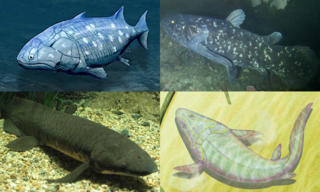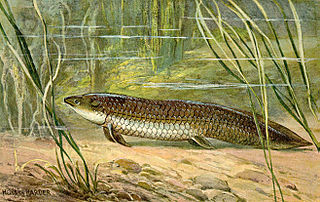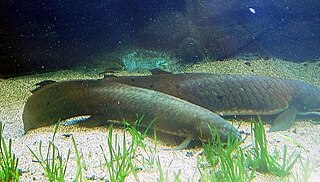
Lungfish are freshwater vertebrates belonging to the class Dipnoi. Lungfish are best known for retaining ancestral characteristics within the Osteichthyes, including the ability to breathe air, and ancestral structures within Sarcopterygii, including the presence of lobed fins with a well-developed internal skeleton. Lungfish represent the closest living relatives of the tetrapods. The mouths of lungfish typically bear tooth plates, which are used to crush hard shelled organisms.

Sarcopterygii — sometimes considered synonymous with Crossopterygii — is a clade of vertebrate animals which includes a group of bony fish commonly referred to as lobe-finned fish. These vertebrates are characterised by prominent muscular limb buds (lobes) within their fins, which are supported by articulated appendicular skeletons. This is in contrast to the other clade of bony fish, the Actinopterygii, which have only skin-covered bony spines supporting the fins.

The Australian lungfish, also known as the Queensland lungfish, Burnett salmon and barramunda, is the only surviving member of the family Neoceratodontidae. It is one of only six extant lungfish species in the world. Endemic to Australia, the Neoceratodontidae are an ancient family belonging to the class Sarcopterygii, or lobe-finned fishes.

Ceratodontidae is an extinct family of lungfish with fossils known worldwide from the earliest Triassic to the Eocene.

The South American lungfish, also known as the American mud-fish and scaly salamanderfish, is the single species of lungfish found in swamps and slow-moving waters of the Amazon, Paraguay, and lower Paraná River basins in South America. Notable as an obligate air-breather, it is the sole member of its family Lepidosirenidae, although some authors also place Protopterus in the family. In Brazil, it is known by the indigenous language Tupi name piramboia, which means "snake-fish", and synonyms pirarucu-bóia, traíra-bóia, and caramuru.

Neoceratodus is a genus of lungfish in the family Neoceratodontidae. The extant Australian lungfish is the only surviving member of this genus, but it was formerly much more widespread, being distributed throughout Africa, Australia, and South America. Species were also much more diverse in body plan; for example, the Cretaceous species Neoceratodus africanus was a gigantic species that coexisted with Spinosaurus in what is now the Kem Kem Formation of Morocco. The earliest fossils from this genus are of Neoceratodus potkooroki from the mid Cretaceous (Albian-Cenomanian) Griman Creek Formation of Australia; remains from the Late Jurassic of Uruguay assigned to this genus probably do not belong to the genus.

Protopterus is the genus of four species of lungfish found in Africa. Protopterus is considered the sole genus in the family Protopteridae, which is grouped with Lepidosiren in the order Lepidosireniformes.

Rhipidistia, also known as Dipnotetrapodomorpha, is a clade of lobe-finned fishes which includes the tetrapods and lungfishes. Rhipidistia formerly referred to a subgroup of Sarcopterygii consisting of the Porolepiformes and Osteolepiformes, a definition that is now obsolete. However, as cladistic understanding of the vertebrates has improved over the last few decades, a monophyletic Rhipidistia is now understood to include the whole of Tetrapoda and the lungfishes.

The Wivenhoe Dam is a rock and earth-fill embankment dam with a concrete spillway across the Brisbane River in South East Queensland, Australia. The dam takes it names from the local Wivenhoe Pocket rural community. The dam wall is located about 80 kilometres (50 mi) by road from the centre of Brisbane. The primary purpose of the dam is the supply of potable water for the Brisbane and Ipswich regions. The dam also provides for flood mitigation control, hydroelectricity, and recreation. The impounded reservoir is called Lake Wivenhoe and the dam, the lake and a narrow strip of surrounding land forms a locality also called Lake Wivenhoe.

Dipnorhynchus is an extinct genus of marine lungfish from the middle Devonian period (Emsian) of Australia.

The Gnathorhizidae are an extinct family of lungfish that lived from the late Carboniferous until the middle Triassic. Gnathorhizid fossils have been found in North America, Madagascar, Australia, and possibly Eastern Europe and South Africa. They are characterized by high-ridged toothplates that form cutting blades and a reduction in cranial bones.

Ceratodus is an extinct genus of lungfish. It has been described as a "catch all", and a "form genus" used to refer to the remains of a variety of lungfish belonging to the extinct family Ceratodontidae. Fossil evidence dates back to the Early Triassic. A wide range of fossil species from different time periods have been found around the world in places such as the United States, Argentina, Greenland, England, Germany, Egypt, Madagascar, China, and Australia. Ceratodus is believed to have become extinct sometime around the beginning of the Eocene Epoch.
Diabolepis is an extinct genus of very primitive marine lungfish which lived during in the Early Devonian period. It contains a single species, D. speratus of Yunnan, China, from the mid-late Lochkovian of the Xitun Formation. It is one of the oldest known lungfish genera. It is the only member of the family Diabolepididae and the order Diabolepidiformes, although neither of these parent taxa have been officially described, despite their names being in scientific usage.
Ferganoceratodus is a genus of prehistoric lungfish known from the Mesozoic of Asia and Africa. Based on morphological evidence, it has either been recovered as a basal member of the Ceratodontiformes or to be the sister group of the Neoceratodontidae.

Gnathorhiza is an extinct genus of prehistoric lobe-finned fish (lungfish) which lived from the Carboniferous period to the Early Triassic epoch. It is the only known lungfish genus to have crossed the Permo-Triassic boundary. Several species have been described, ranging in size from 5 to 50 centimeters.
Ctenodus is an extinct genus of prehistoric lungfish and the longest-surviving genus of Carboniferous lungfish.
Rhinodipterus is an extinct genus of prehistoric dipnoan sarcopterygians or lobe-finned fish, that lived in the Devonian Period, between 416 and 359 million years ago. It is believed to have inhabited shallow, salt-water reefs, and is one of the earliest known examples of marine lungfish. Research based on an exceptionally well-preserved specimen from the Gogo Formation of Australia has shown that Rhinodipterus has cranial ribs attached to its braincase and was probably adapted for air-breathing to some degree as living lungfish are. This could be the only case known for a marine lungfish with air-breathing adaptations.

Ptychoceratodus is an extinct genus of lungfish living from Early Triassic to Middle Jurassic. It was established by Otto Jaekel for one species, transferred from Ceratodus genus. Type species is P. serratus from the Middle Triassic of Switzerland and Germany. Ptychoceratodus had two pairs of massive dental plates, bearing 4-6 acute ridges. Its skull roof was composed from massive, plate-like bones. In the central part of skull roof was localized an unossified fenestra. Most of the Ptychoceratodus findings are isolated dental plates, some associated with jaws. Other parts of skull or postcranial skeleton are relatively rarely found as fossils. The anatomy of skull is the best recognized in P. serratus, whereas less complete cranial material is available also for P. concinuus, P. phillipsi, and P. rectangulus. Although Ptychoceratodus is known exclusively from the Triassic and Jurassic, there were also Cretaceous specimens referred to this genus. However, they are more often regarded as representants of Metaceratodus. Ptychoceratodus is the only member of the family Ptychoceratodontidae. The first named species is P. phillipsi by Louis Agassiz in 1837 as a species of Ceratodus and later moved to Ptychoceratodus genus. Occurrences of Ptychoceratodus come mainly from Europe. However, occurrences from other continents suggest it was dispersed globally during the Triassic. After 2010, the new fossil material behind the Europe was reported from South America, India, and Greenland

Neoceratodontidae is a family of lungfish containing Neoceratodus and the extinct Mioceratodus. It, Lepidosirenidae, and Protopteridae represent the only lungfish families still extant.

Ceratodontiformes is the only extant order of lungfish, containing the families Neoceratodontidae, Lepidosirenidae, and Protopteridae as well as many other extinct groups. Members of this group are the only lungfish known to have survived the Permian-Triassic extinction event. Although lungfish originated in marine environments, the Ceratodontiformes have been an exclusively freshwater group since the Carboniferous. This order was formerly considered the suborder Ceratodontoidei.














